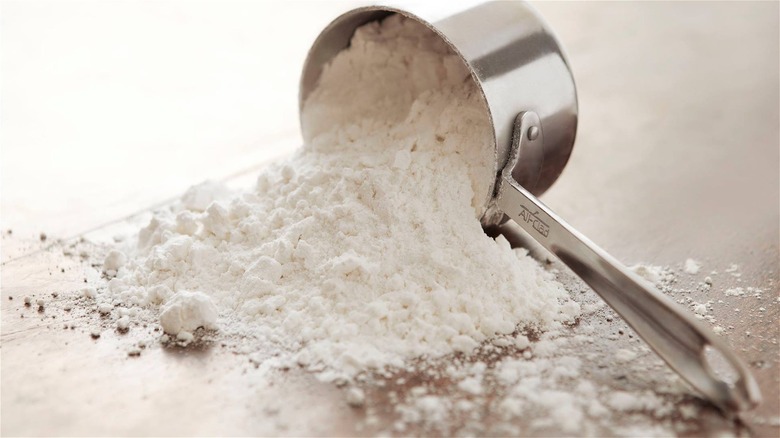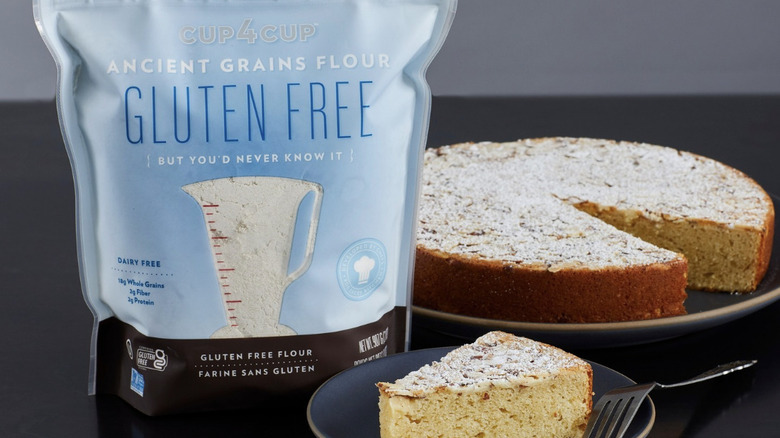Chefs Absolutely Swear By The French Laundry's Gluten-Free Flour
Over the past few decades, Americans have become obsessed with gluten-free eating regardless of whether it was medically prescribed. The U.S. National Library of Medicine reports that there is little evidence to support the merits of a gluten-free diet unless you have health issues like celiac disease. Gluten and all the delicious foods associated with it, like bread and pasta, became taboo for the health conscience and dieters looking to shed a few pounds.
Interestingly, the correlation between gluten and celiac disease became evident during World War II when celiac patients, despite food shortages, grew stronger. Dutch pediatrician Dr. Willem-Karel Dicke observed his celiac patients, unlike scores of malnourished children, were thriving despite the lack of fresh fruit, vegetables, and wheat. Dicke's paper on the effects of a wheat-free diet is credited with discovering the toxicity of gluten to celiac patients.
Today's gluten-free food market is booming, and the industry is projected to more than double in the next 10 years to $14 billion, per Statista. While almost 1,000 gluten-free products were launched in 2020, gluten-free home baking can be intimidating. Baking is a science requiring exact measurements, and the same recipe can result in different outcomes when factors such as humidity, altitude, or temperature change. Gluten-free baking introduces additional challenges and often contradicts traditional baking wisdom. Unlike standard recipes requiring a single flour to provide structure, gluten-free baking often needs a combination of flour and starches — products like French Laundry's blend simplified gluten-free baking, which is why chefs love it.
This flour is gluten free
To compensate for the lack of gluten, gluten-free baked goods typically require a mixture of flours and starches, multiplying the number of ingredients in a recipe to help with the texture, binding, elasticity, and moisture content, making it challenging to adapt your favorite recipes for gluten-free diets.
Cup4Cup, a 1:1 gluten-free flour blend, allows bakers to convert conventional recipes to gluten-free without complex conversions. Offered in three combinations, ancient grains, wholesome, and multipurpose flour, the blends replace all-purpose or whole wheat flour in most recipes, whether you weigh or scoop the ingredients, without compromising "taste, texture, or performance." Although the flour performs well in most baked goods and savory cooking, the company warns that bread recipes require more structure and additional modifications.
Cup4Cup was developed at Thomas Keller's restaurant The French Laundry in 2010 by culinary researcher Lena Kwak. Wanting gluten-free guests to enjoy their signature dish, a Cornet of Salmon Tartare, the first blend was created. The product line grew to ten items, including gluten-free baking mixes. Before a 1:1 blend, bakers weighed their ingredients since gluten-free flours and starches have a finer consistency than wheat flour, making the traditional 'scoop and level' method of measuring very inconsistent. Cup4Cup combines corn starch, brown rice flour, white rice flour, milk powder, tapioca flour, potato starch, xantham gum, cassava, millet, bran, and oat into a convenient blend. Cup4Cup baking mixes retail for $8.99, and flour blends begin at $13.99 for a two-pound bag, available online and in select grocery stores.

